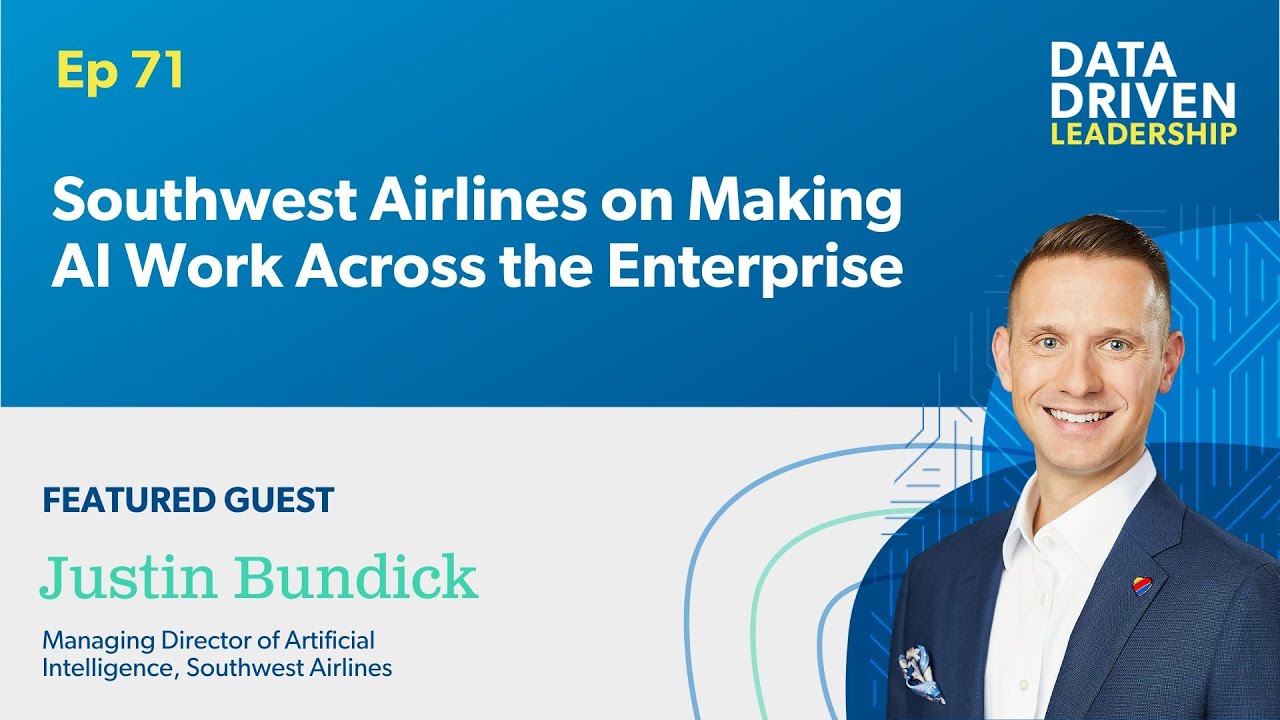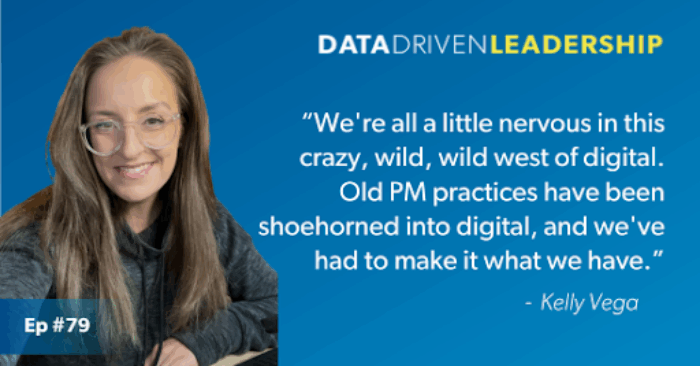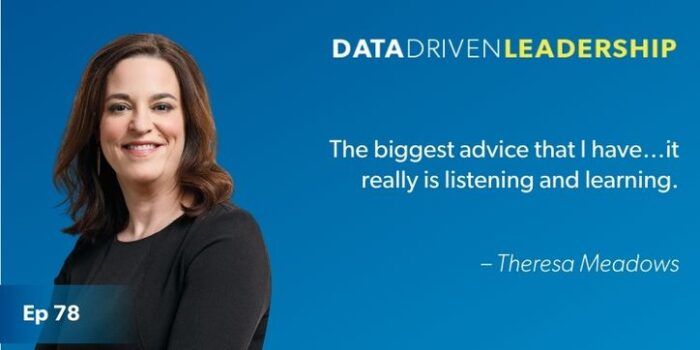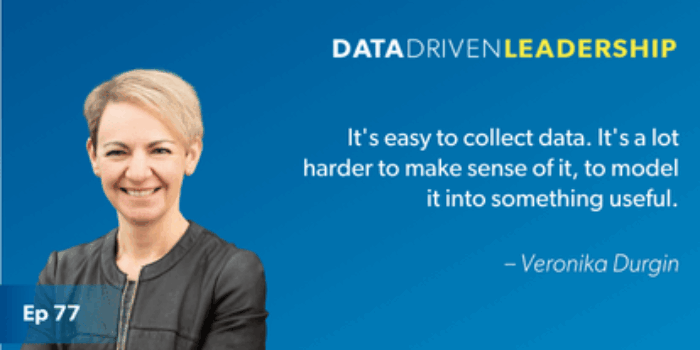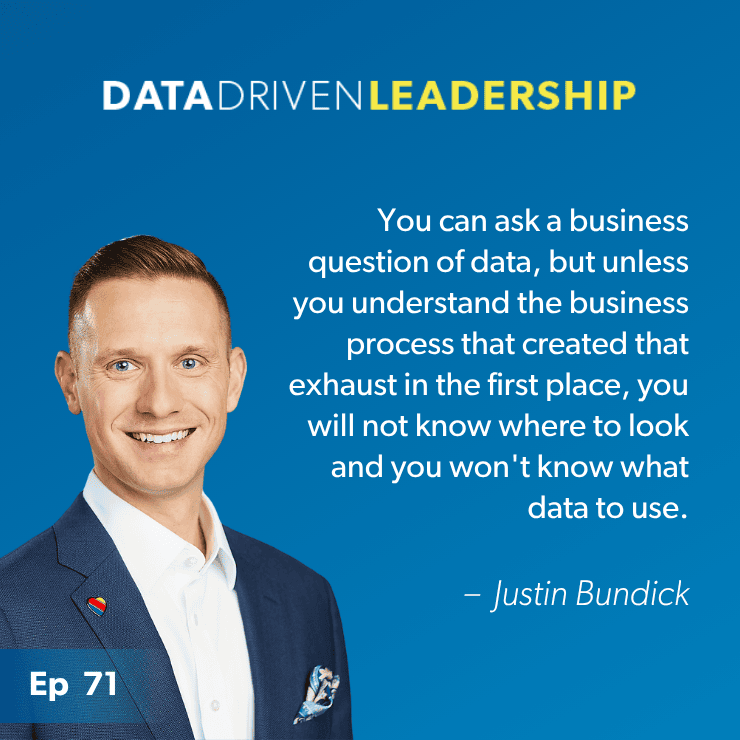

Transcript
Show ID [00:00:04]:
The power of data is undeniable. And unharnessed, it's nothing but chaos.
The amount of data was crazy.
Can I trust it?
You will waste money.
Held together with duct tape.
Doomed to failure.
This season, we're solving problems in real-time to reveal the art of the possible. Making data your ally, using it to lead with confidence and clarity, helping communities and people thrive. This is Data-Driven Leadership, a show by Resultant.
Jess Carter [00:00:34]:
Welcome back to Data-Driven Leadership. I'm your host, Jess Carter, and I'm thrilled to have you join us for another episode. Today marks a special milestone for our show as we welcome our second guest from Southwest Airlines. Typically, we like to diversify the industries and roles that we highlight.
[00:00:48] The Southwest has been doing such innovative work in different areas of their business that we couldn't resist featuring another incredible leader from their team. Previously, we had the pleasure of speaking with France Grenot, managing director of IT data foundation business delivery. If you haven't caught that episode yet, be sure to check it out after this one.
[00:01:05] France shared some outstanding insights. Today we're excited to delve into another innovative aspect of our airline with Justin Bundick, the managing director of artificial intelligence at Southwest. Over his remarkable 17-year tenure at Southwest, Justin has witnessed the integration of AI and has become the first managing director of artificial intelligence at the company.
[00:01:25] His role spans across the organization, focusing on enterprise-wide and enablements, utilizing bespoke AI solutions internally and incorporating AI into existing software. One of the things I really enjoyed about this episode was listening to Justin describe how AI works and how it really sits on top of all of the other important IT infrastructure that so many of us are familiar with, and how important things like data governance, data cataloging, and really understanding at what point in what business process is the data
[00:01:55] collected and what business processes are we trying to make a difference or impact it. I think Justin also resembles being a really great leader.
[00:02:03] I think that he's acknowledging of his team and how they fill holes in his experience or capabilities, sharpening the whole team and making them better at what they're trying to accomplish every day. I'm so excited for you guys to hear this episode. Justin was so much fun to talk to. Let's dive into it.
[00:02:21] Jess Carter: Welcome, Justin.
[00:02:23] Justin Bundick: Thank you. Thanks for having me. It's great to be here.
[00:02:25] Jess Carter: Awesome. Well, okay, we’re gonna jump right in 'cause I, I have so many
questions for you. This will feel like an interrogation.
[00:02:32] Justin Bundick: All right, all right. I’m bracing.
[00:02:35] Jess Carter: Good, good. So I have not had the pleasure of talking to someone at such a significantly, an enterprise firm that has this title of like, director of AI. I saw that you've been there for 16-ish years. Is that right?
[00:02:49] Justin Bundick: In my 17th year at Southwest. Yeah.
[00:02:52] Jess Carter: Okay, that was maybe one my questions is like, do you remember? Like, when did Southwest make the move to have a AI managing director? Were you the first one?
[00:03:00] Justin Bundick: I was the first managing director of AI, for sure. So a little bit of background on my, myself, Jess, and I'll fill in the gap of how we got here. So I feel like my career at Southwest has really aligned nicely with Southwest's adoption of the use of data to drive better intelligence
[00:03:18] overall at the company. So, when I started here, at Southwest, I started in one of the first, business intelligence organizations that Southwest was standing up.
[00:03:26] We had invested heavily in a more centralized enterprise data warehouse. Obviously as an airline, just like any other airline, we capture a lot of data,
[00:03:36] regulatory and safety purposes and for other purposes. And so building that out many decades ago now was really, really important to the company. And so we started to demonstrate and show how you could use data to really drive better decisions,
[00:03:52] and as the use of data and decision making really matured in the marketplace, the company continued to adopt those technologies into the organization. So the first part of my career was really helping business units be able to start to use data and information to make better decisions, right?
[00:04:10] So democratizing what I would call descriptive and diagnostic analytics out into the company so that it's used by thousands of people to make better decisions, right?
[00:04:21] At the same time, our company for a long time has been investing in optimization solutions. To operate an airline of this scale and magnitude, you have to have tools and capabilities like that.
[00:04:34] But in the early 2000s, we really started to invest in capabilities around machine learning and the use of machine learning capabilities to help drive better insights, both from a diagnostic perspective as well as starting to get into more predictive capabilities. And we continue to invest in that, up until today, obviously.
[00:04:55] And so it was the late, I would say, 2017, 2018, when we really started to call it artificial intelligence, data science. Then obviously with OpenAI's burst onto the marketplace with ChatGPT and the inclusion of generative AI and some of the newer capabilities that are coming into the marketplace,
[00:05:15] we really focused and double down on artificial intelligence as a capability and invested as a department in that.
[00:05:21] Jess Carter: So, okay. There's so much in there I even wanna unpack. So like if I followed you correctly in the, call it early 2000s, maybe before that, the first step was an enterprise data warehouse put the data all in one place and help it solve, answer questions, or demonstrate data that helps us make decisions in a department.
[00:05:40] So like, can you gimme a for instance?
[00:05:42] Justin Bundick: Yep. Sure. For instance, we have a ton of information in our operation, let's say, available for day-after analysis. In some instances, we do intraday analysis, depending on the level of visibility we need to provide.
[00:05:59] But we have departments that are out doing that. They're answering business questions using data. So that way they're answering those questions with facts, rather than with gut.
[00:06:09] And that's just in the operation. We also have teams in our commercial organization around revenue, around network, around marketing, where our customers are in their journey, where we need to be meeting our customers in their journey.
[00:06:21] And then there's other areas, obviously, on the enterprise side, around our people, and how we can help facilitate a better employee experience with use of data.
[00:06:30] Jess Carter: Okay, because I think Bain does this where, and I, I just like the phrase where they kind of describe all of their strategic initiatives, or they used to at some point as like a hypothesis. And so I think about an airline, I'm completely unfamiliar with it. Let's just start there. Like, that's not my business.
[00:06:43] I've not spent 16 years in an airline, but I have this imagination for, if you wanted to decide where to open up a new direct flight, there's no data about who would want that, per se, that's self-evident. But there might be signs and signals in the data that you do have, that there's connections, and it's so that first step was let's start using aggregated data in a thoughtful way to understand what's going on in our business,
[00:07:08] looking back, looking quickly back, sometimes half day or whatever. Then you move into the predictive side or some of the machine learning to say, let's build models to understand. If we're gonna pick a hypothesis or pick some strategies for the business,
[00:07:22] how do we, directionally, maybe use machine learning to bet on the best things? Is that right?
[00:07:28] Justin Bundick: Absolutely. Yeah. If you think about predictive analytics, you can use it to give the most likely outcome, or you can use it to think about it in terms of what are the spectrum of outcomes that I should utilize to triangulate the best answer. Right? And so, the most likely outcome is where you get to the best route you should drive when you're using one of the map applications on your phone or in your car, right?
[00:07:52] But you can also use it to really identify the spectrum of potential outcomes and simulate out what that would look like, and then use that to better figure out what might be next best route or what might be the best pricing or time of day for that particular route, as an example.
[00:08:07] Then you can use that in the operation, right? So if you think about…so that's commercial side. If I take this to the operation, if you think about an organization like ours, any airline, right? We're actually flying multiple networks at the same time, right? So you have your aircraft network, you have your crew network, you have your customer network.
[00:08:26] We have a cargo network, we have a baggage network, and actually wrapped around all of that and connected to our aircraft, we actually have a maintenance network because our aircraft, just like any other machine, has to be touched and serviced. And so if you think about all of that and you think about these moments of convergence
[00:08:44] and divergence that are happening with all of these assets and people and commodities as we operate throughout the day, and you think about our point-to-point network where we're not a hub and spoke, but we're actually converging and diverging in hundreds of locations throughout the day, it's a very complex system.
[00:09:03] And if you don't use data to pinpoint where you're having problems and where you should be focused, you can get lost in the noise. And so that's really a great way that we use data and use AI with our data to better unlock where we should be focused as an organization to make sure that we're running a really high quality operation and product for our customers.
[00:09:25] Jess Carter: That is such an important sentiment 'cause I think the number of clients I've had where they're kind of like, hey, we know data's important. We know that it can be really valuable. It can help us with efficiencies. It can help us optimize. It feels like the data entity is shooting blanks, if you will. Like, they're struggling to be like, when we sit down and talk to them, and I've seen this at least three different times in the last few years, it's like, well, we have our EDW, our data warehouse. We ask it a question. And we, like, take six weeks to analyze it and figure out what the answer is.
[00:09:57] Jess Carter: I think where you are pivoting is, it's so much more than AI because what you're teaching people to do, you're building the right models and you're setting up the right structure. I think you're teaching people when it comes to that noise versus signal. Like how do you get the right vantage point to listen to your data?
[00:10:14] And see where it's taking you? Because you can get nowhere for a year and a half if you keep asking your data the wrong questions in long six-week cycles to see what your analyst tells you, right? It feels like you’ve unlocked that. How did you do that?
[00:10:30] Justin Bundick: Yeah, so, through a couple of work streams that then kind of converged, over time, right? So I talked earlier about the investment our company made in the enterprise data warehouse. Over the years, we've actually invested further in that. We call it our Integrated Data Foundation now.
[00:10:46] And there's a sister team that I work with that’s heavily involved in building and maintaining that infrastructure. It's a scalable set of infrastructure on cloud that we have access to, that then we use to train our models on. I think what's really important is that we are working towards a strategy where we're capturing all digital exhaust that's being created.
[00:11:09] That may be your bits and bytes coming from your systems, but it also may be information that's being created in documents and images and voice, and how do you then capture that, but more importantly, structured in a way where you can align it to the business processes that created that digital exhaust?
[00:11:27] That, I think, is the critical unlock that a lot of folks that I interact with don't make. You can ask a business question of data, but unless you understand the business process that created that exhaust in the first place, you will not know where to look and you won't know what data to use.
[00:11:42] And that's the really, the crux of it that we try to really double down on because that's really how you get to a really sophisticated AI in general.
[00:11:52] So you have to understand the business process and you have to understand what in that process you're actually trying to augment or automate because unless you understand that, you're not gonna know what to build or how to build it.
[00:12:04] And the same can be said for analytics that maybe is more advanced analytics and maybe not using true AI, but it’s the same process that you're deploying against the data that you're using.
[00:12:14] Jess Carter: What I'm implying, that there is a role for data cataloging, data governance and all of that, is that accurate?
[00:12:23] Justin Bundick: Absolutely. You need data cataloging, data governance to help you understand and structure the information that you're capturing in the right way. It helps you manage access, security, all the things that help create the environment of safety to be able to use that data appropriately, right?
[00:12:41] And to be able to understand what that data is, what it means, and where it came from ‘cause that lineage is really important.
[00:12:47] But then you've gotta apply just good analytic practices. We apply human-centered design in our processes…
[00:12:55] Jess Carter: You have to say what that is.
[00:12:55] Justin Bundick: And that's really helping.
[00:12:56] Jess Carter: I know what that is, but I think you have to define what's human-centered design.
[00:13:01] Justin Bundick: Yeah, so it's really about understanding the human component and element of a business process and how a person is interacting with that process, and then what data…we take it to the point of what data or digital exhaust is being created from the process through those interactions and being able to dissect that.
[00:13:20] It's a methodology that you take, an approach that you take to then dissect that business problem into the ultimate, probably, multiple problems that you're actually trying to stitch together to get to the answer you're trying to solve.
[00:13:31] Jess Carter: I'm a Six Sigma black belt. And so when we did some IDEO design thinking training, it's that concept of, I think in, in Six Sigma. It's been a while since I've used it, literally. But it's the DMAIC: design, measure, analyze, inform, improve, control. And I think human-centered design starts with empathy.
[00:13:47] The first concept is, let's start with the human experience. Where are we meeting people on their journey? What are we trying to accomplish? Is that right?
[00:13:54] Justin Bundick: That's exactly right. And so if you apply that to a data from a data perspective, it helps you better identify those processes, and how they're creating the exhaust that they're creating.
[00:14:05] Jess Carter: Yeah. And probably the accuracy of the data.
[00:14:07] Justin Bundick: Oh, absolutely.
[00:14:07] Jess Carter: What’s the process and what's the likely accurate, is somebody flying as fast as they can through a step because they're trying to get somebody a ticket? Or is this like a slow down in audit and then the fidelity's gonna be better?
[00:14:16] Justin Bundick: Right. So if you take that and play that forward, I was talking earlier about infrastructure, what we built out. So if you take that integrated data foundation, we have data flowing between producers and consumers, technology systems. They also may just be document repositories, right?
[00:14:33] That information is then being captured from a historic record perspective in its rawest form and then we're aggregating it where needed for more efficient and effective reporting, analysis, and other things. My team tends to use the raw data a lot more because when you're using data in its rawest format, you can understand patterns a lot more effectively.
[00:14:55] And so we typically use that part of our data infrastructure. But then we build models on top of that data, and train those models, and then we have the capability here at Southwest Airlines to then deploy those models into production and manage them just like software assets. And those models then are creating inferences.
[00:15:12] Maybe we set them to run. If an event happens, it reruns and recalculates an output, right? That inference then flows back through the data ecosystem, so that way consumers that might need that data, may that be a person through a visualization or an application, through some type of API or data synchronization is then consuming that inference and it's being used inside of the operation.
[00:15:36] Jess Carter: Okay, man, I have so many questions. So, what I am picking up right now, based on the way you're even talking about how you're using AI across Southwest, is that, and we talked to Frances a few weeks ago too, right? And she kind of said this too, so I'm, I want you to correct me if I'm wrong.
[00:15:51] It feels like you are leveraging AI broadly across the organization in so many different ways. I think a lot of, you know, there are product companies where their number one use of AI is either optimization or like an AI agent to help them with something.
[00:16:05] But it's like either customer-focusing or it's operations-focusing.
[00:16:09] It feels like you are broadly building the muscle to be able to leverage it for whatever the business needs in any of these ways. It's not like you're solely focused on customer experience or something. Is that right?
[00:16:19] Justin Bundick: Yeah, our role is more enterprise-focused. We're using it in multiple different areas, and to me, we've got two really key things that we need to enable in the organization. One is the capability to build bespoke AI. And that may be traditional machine learning AI. It may be a generative AI or in the near future agentic-type AI. That's more bespoke and internal to Southwest.
[00:16:45] But what we're also enabling is the ability for us to utilize other software that might have AI built into it that's specific to that piece of software, but be able to provide the data to that software necessary for that AI to work effectively, and to meet the need, wherever that software lives.
[00:17:02] So that's really the role that we're trying to play in the strategy that we're trying to roll out here.
[00:17:07] Jess Carter: Which comes all the way back to security, governance, cataloging. Right?
[00:17:11] Justin Bundick: Absolutely. Yeah. So data cataloging and governance is one thing. I've got a team in our organization focused on AI governance, and that's a whole different ball game, and set of regulations that we've gotta think through and set of processes that we have to have in place to make sure that the AI is not only meeting just the fundamental regulations that we need to abide by,
[00:17:32] but is also meeting our ethical standards, meeting our bias standards, and maintaining the efficacy that we need the AI to maintain over time as the world around us evolves.
[00:17:42] Jess Carter: Right. Okay. I just have to ask you this. So obviously Southwest has been the news recently, so it's the whole like, we're going away, we're doing seat assignment, right? And there's a bunch of changes to bags.
[00:17:55] So I’m curious, did we leverage Justin's models to see how people may react to like the seat assignment thing? Like was that a AI tool process? Did we walk through that, or no?
[00:18:08] Justin Bundick: Jess, I, the way I would answer that is I… there was a ton of analysis done,
[00:18:12] Jess Carter: Okay.
[00:18:12] Justin Bundick: using the data infrastructure that we have and the tool set that we have.
[00:18:16] Jess Carter: You didn’t build an anonymized dataset of Jess Carters to see if she's gonna be excited when she can definitely secure that she's gonna sit with her kids or not on the next flight.
[00:18:26] Justin Bundick: Yeah, I think there was a ton of analysis. We obviously… these are big decisions that the company's making that have been announced and there're changes that we know we're gonna meet our customers’ needs and wants. And so there was a lot of work done and those decisions were data-driven.
[00:18:43] And so I think that's the fundamental thing that I would want to get across. And it's exciting that we as a company had the infrastructure and the data available and the capability available to do those types of analysis and feel confident about the decisions that we're making.
[00:18:57] Jess Carter: Yeah. And I think you, for me, I think the curiosity, too, is like, those are big hypotheses and predictions where I'm like, hey, I've shared this on other episodes, probably not in enough detail, but, I helped run the governor's response to COVID in Indiana in 2020. And we had a really hard time because all the epidemiology models are from the 1950s.
[00:19:18] Jess Carter: And so they’re curved and you're fitting it to a curve and it's not actually…so we kind of built our own model after trying 18 times. And none of them worked because they, weren't, I mean, I remember this one called Twin Stem, but we couldn't figure out…the results looked like we all should have had COVID at the same time. And it worked in Italy. It was absolutely signaling the right way in Italy. And we thought, well, what's different in Italy than in Indiana? And all, you know, as we all talked about it with these really smart scientists and a whole bunch of other people, it was like, well, they kiss each other when they greet and they're generally an older population.
[00:19:49] AI can be so mystified because it is complicated and it is different and we, we talk about models, I think a lot of people don't understand what this really means. So to your point about, you know, if you have this AI muscle you're building, I'm so intrigued about when we're like, let's pull the lever on AI usage and modeling versus let's do a deep analysis because those are costly and different, and so I imagine Southwest uses all of those tools differently depending on what they're trying to accomplish.
[00:20:17] Justin Bundick: Absolutely. And I think one of the differentiators where you move to maybe more advanced machine learning is when the decision that you're making is more heavily reliant on predicting what might be, rather than answering business questions on what was,
[00:20:32] and I think that's where you can start to use more sophisticated machine learning to be able to help with that. But Jess, you brought up an interesting point in, in your story, and I wanna connect it back to something I said earlier. You were talking and this concept of applying a methodology to understand a business process and how that then creates data exhaust. The way we then translate that into analysis and modeling is through, we call it factor mapping.
[00:20:58] But you call it variable mapping. There are other terminology you can use, but it goes to your point of if you've got a business problem, or a problem in general, that you're trying to solve, and you understand the process of how it's created and where the problem exists in that process, the next thing you've gotta ask yourself is what are all the variables that could influence whatever part of that process?
[00:21:22] You brought up modeling in Italy versus Indiana and the variables that you pointed out that are differences, right? That type of work is something that we do early in our process where we deconstruct a business problem and start to identify all the potential variables, and then you use machine learning and statistics to actually validate if those variables actually influence the outcome or not.
[00:21:46] Jess Carter: Amazing.
[00:21:46] Justin Bundick: And that helps you then downselect to the variables or features that you're actually gonna build into your machine learning algorithm.
[00:21:54] And with generative AI on the scene now, it can actually help you do that maybe even more efficiently than the old school ways of doing it, of test and retest and test and retest.
[00:22:04] But that's really how you take this nebulous business problem and really start to get down to the data elements you think you're gonna need to actually build a sophisticated model.
[00:22:12] Jess Carter: Okay. So, gosh, question one here. Justin, are you a data scientist? Like one of the things I'm, I'm impressed by is, you know infrastructure and security and governance and AI because you're formally trained in those things?
[00:22:25] Justin Bundick: I'm not formally trained as a data scientist, statistician. So learning on the job and all the years of experience that I've had in building out this capability is how I've developed the knowledge that I have.
[00:22:37] Jess Carter: That's amazing.
[00:22:38] Justin Bundick: I've been blessed to have a really incredible team around me of really sophisticated folks, bringing a ton of knowledge to the table and I am so blessed to be a sponge, be able to absorb that.
[00:22:51] Jess Carter: That’s awesome.
[00:22:52] Justin Bundick: And be an advocate for them here in the company.
[00:22:53] Jess Carter: Absolutely. Well, and then I'm thinking, because I haven't had the chance to talk to, like, a managing director of AI, like, I'm trying to picture you in a board meeting representing value because it's different right?
[00:23:06] Justin Bundick: Yeah. So representing value of AI, it really goes back to knowing and understanding the process you're trying to influence and how you're gonna influence it. Then you can use data to understand the volume of instances you're trying to mitigate or change, and the impact that those instances have. And then it's a p time q model and value becomes much more of a simplified equation.
[00:23:32] Jess Carter: That’s accessible 'cause otherwise I'm like, it's like you almost need a board that's educated in some of this stuff. You know most of the time that’s not true. They're also not data scientists most of the time. Right? So the content can get complicated quickly and it's impressive to me.
[00:23:48] It's obviously a skillset of yours that you've learned. I had a leader that I highly respect and he’s an executive and I remember at one point he was like, Jess, Jess, Jess. Horsey, doggy, piggy. Like you gotta, even for, especially for executives, we're busy, we don't have enough time. Like you gotta simplify everything for us to make it move quick. And I imagine that's tricky with AI.
[00:24:06] Justin Bundick: It's very tricky and we spend a lot of time actually doing that. We want, for a couple of reasons. We want this to be accessible, A, so we've gotta train people on how to use it, but it's gotta be understandable in order to be trusted.
[00:24:21] Justin Bundick: That’s any analysis. That’s not even just machine learning or beyond, right? That's any analysis that you're doing.
[00:24:27] So investing in time for your people to be able to learn how to communicate what they're doing as well as the outcomes that they're producing is super important in any corporation.
[00:24:41] And to be able to do that in the right way is just important to be able to demonstrate value long term.
[00:24:47] Jess Carter: That's awesome. Okay, maybe one of my last questions for you, for now. Robots on Mars. When you dream, I mean, when you look at what AI could do for Southwest the next three to five to ten years, like what gets you super excited?
[00:25:01] Justin Bundick: I believe that the airline industry is one of the most complex industries in the world, and what excites me about artificial intelligence in general, both machine learning, generative AI, and the agentic future that's coming, is that I think that it's gonna reduce friction in our employee and customer experiences, and it's gonna be small pieces of friction that it reduces. But over time, that's gonna compound into something that's really significant.
[00:25:35] And it's gonna show up differently depending on where you are in the organization, right? If you're a customer, it's gonna show up in more efficient and effective service from our employees that are interacting with you, as well as if you're interacting with our digital footprint, right?
[00:25:50] In the backend for our operation, it's gonna show up in providing our employees with the right information at the right time. That includes forward-looking information about the decisions they're making and the impact that could have to help them make more informed, more appropriate, more timely decisions.
[00:26:08] That then reduces the overall volatility that you might find in a daily operation at an airline.
[00:26:16] In a world of constraints where volatility is increasing—we have a national airspace with more and more aircraft, we have more and more passengers flying, we have more volatility in terms of weather and other events that are out of our control—
[00:26:30] having the ability to manage that effectively is gonna be really key to maintaining a really high quality product for our customers and to be able to maintain really good customer experience, which Southwest values and prides itself on. And so that, I think, is what's most important and I think what's most exciting about AI in the airline industry.
[00:26:50] Jess Carter: Yeah, for sure. Well, I hadn't even thought about, to your point, the challenges the industry has faced lately, and weather! I hadn't even thought about it. It's just like this is highly federated, changing every minute and there are like, actual events outside of anyone's control that you can barely predict sometimes.
[00:27:08] So it, to your point, it's, it's exciting to get to work on, I imagine, because it's like, to me... I used to interview people and the question I would ask is, what's the most complex problem you've ever solved? Like, I just think that's a cool thing to think about, and I feel like it would be like working at an airline.
[00:27:26] Justin Bundick: Yeah. Yeah.
[00:27:26] Jess Carter: It's tough.
[00:27:27] Justin Bundick: It's, it's tough. It's a dynamic daily operation that we are interacting with and so, it's something that I think is ripe for more propagation of AI to help make our world a better world and make our industry a more efficient and effective industry.
[00:27:44] Jess Carter: Yeah, absolutely. I am reserving the right to beg you to come back for another episode. Whatever you'd like to.
[00:27:49] Justin Bundick: We've covered a lot, Jess. It’s been a great conversation. I really appreciate it.
[00:27:53] Jess Carter: This has been so helpful. I think it's so interesting. I think your leadership skills that we haven't even touched on, but I think they're very self-evident, your leadership skills and your technology leadership. I get excited about people like you in this seat on a bus because I think you are exemplifying what can be possible with the right leadership culture, the right strategy, the right support and staffing. So I'm just so excited that you spent time with us today.
[00:28:19] Justin Bundick: Well, I appreciate that and I appreciate those compliments. It was very nice to be here today and chat with you. It was a great conversation.
[00:28:25] Jess Carter: Awesome. Thank you so much, Justin.
[00:28:27] Justin Bundick: You bet.
[00:28:28] Jess Carter: Justin, where can people go to learn more about this work you're doing or connect with you?
[00:28:33] Justin Bundick: Absolutely, so they can find me on LinkedIn. Just search my name, Justin Bundick, and you will be able to find me there and, and connect with me.
[00:28:41] Jess Carter: Perfect. Okay. Thank you for listening. I'm your host Jess Carter, and don't forget to follow the Data-Driven Leadership wherever you get your podcasts. And rate and review letting us know how these data topics are transforming your business. We can't wait for you to join us on the next episode.
Insights delivered to your inbox


